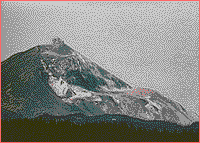
|
 |
 |
The observations you just read describe Mount St. Helens when it erupted on May 18, 1980. This "very large" eruption was the worst volcanic eruption in the recorded history of the U.S. It's also the most extensively studied eruption of any in the world to date.
What's in the Future?
Photos: Gary Rosenquist. Source: "Eruptions of Mount St.
Helens: Past, Present, and Future." (USGS)
Planning for Disaster | Resources | Teacher's Guide Transcript | Printable page | Site Map | Vesuvius Home Editor's Picks | Previous Sites | Join Us/E-mail | TV/Web Schedule About NOVA | Teachers | Site Map | Shop | Jobs | Search | To print PBS Online | NOVA Online | WGBH © | Updated November 2000 |
 This series of photos shows the landslide and lateral
blast that happened within the first few minutes.
This series of photos shows the landslide and lateral
blast that happened within the first few minutes.